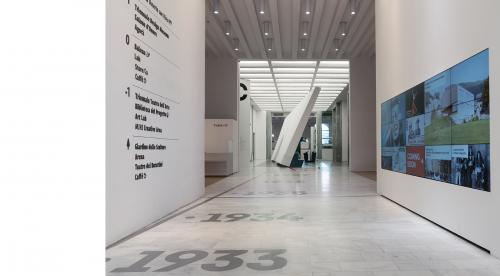“... What’s in a name?” An exhibition about the Census of the Jews in Milan in 1938

On the occasion of the 80th anniversary of the introduction of fascist antisemitic laws, the CDEC Foundation, in cooperation with the University of Milan, Cittadella degli Archivi, and the Holocaust Memorial Foundation in Milan, presents an exhibition dedicated to the census of the Jews living in Milan in 1938.
The exhibition is curated by Laura Brazzo (CDEC Foundation), Emanuele Edallo (University of Milan) and Daniela Scala (CDEC Foundation) and is open from 23 October to 18 November at La Triennale di Milano, one of the most significant and culturally relevant locations in Milan.
The census of 22 August 1938 was the first nationwide, racist and discriminatory act carried out by the Fascist regime against the Jews. For the first time in Italy, Jews were surveyed separately from the rest of the population; for the first time, they were classified (and counted) as “belonging to a race” and no longer to a "religion".
How many Jews were affected by the 1938 census in Milan? Who were they? What was their fate? The census archive, recently discovered in the deposits of the Municipality of Milan, allows us, after decades, to answer these questions.
According to 1938 estimates, between 55,000 and 70,000 Jews lived in the Kingdom of Italy. At the beginning of 1938 the General Directorate for Demography and Race (DEMORAZZA), supported by Prefectures and Municipalities, organized a massive but silent survey of the Jews living all over the country.
The results of this special census were never made public.
In Milan specifically, on the eve of the census, the estimated number of Jewish inhabitants ranged, according to different sources, from 6,200 (Union of Italian Jewish Communities) to over 10,000 (Ministry of the Interior).The results of the census were reported (although not publicly) by the podestà, Gian Giacomo Gallarati Scotti. 4059 census forms were compiled, amounting to 11,384 people surveyed. Of these, 6,844 were Italians and 4,540 foreigners.
New research recently carried out on the racist census in Milan - discovered in 2007 and now held in the Cittadella degli Archivi of the Municipality of Milan - shed light on the actual numbers of the people surveyed as well as on their identity and other biographical details. This research shows that 3,788 census forms were filled out, amounting to 3,788 families or 10,591 Jewish individuals. 6,531 people were Italians, 3,818 were foreigners and 242 declared no nationality.
Out of the total surveyed, 8,034 were later classified as “members of the Jewish race", 2,257 as non-members. In 300 cases, membership of the Jewish race remained undetermined.
Data about foreign Jews in Milan is especially significant. One third of them were of German nationality, with many others coming from Eastern European countries including Poland, Hungary, Czechoslovakia, Romania, Bulgaria and Yugoslavia. It is remarkable (but perhaps not surprising given the actions of Kristallnacht) that most of the surveyed Jews in Milan coming from foreign countries had moved to Italy in the same year as the survey was carried out.
The Census and the Exhibition on the Census
The 22 August 1938 census of the Jews was a clear break in the life of individuals as well as in the history of Italy. It should be read as the preliminary and premonitory act of a more extensive and profound censorship process undertaken by the Fascist regime through the enactment of antisemitic Laws (RDL n. 1728, November 17, 1938). These laws pushed Jews out of Italian public life: they were expelled from workplaces, schools, all associations or clubs whether public or private, cultural or recreational. The racial laws enacted by the Fascist regime in 1938 did away with the emancipation of Italy’s Jews and tried to deprive them of their identity too.
In the exhibition “... What’s in a name?”, this tragic event is (re)presented in a narrative form signaling a distinct departure from the traditional documentary format. The stories of individuals, shaped as biographical micro-illustrations, are presented to great emotional impact. Names and fragments of the personal stories of the 10,591 people surveyed are shown in this exhibition - a story that is both individual and collective at the same time.
The exhibition would not have been possible without the work of Morpurgo de Curtis Architetti Associati Studio, who designed the layout; Giorgia Lupi and her Accurat studio who worked to represent the individuals using original visual narration; and the Unità SIT Centrale e Toponomastica of the Municipality of Milan whose software was vital in virtually rebuilding the streets of Milan as they existed in 1938. All these elements were conceived to work together as a unique, sculpturally shaped “organism”, aimed at leading the visitor through both an emotional and cognitive experience and a stimulating reflection on the present political climate.
Laura Brazzo